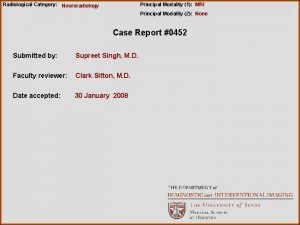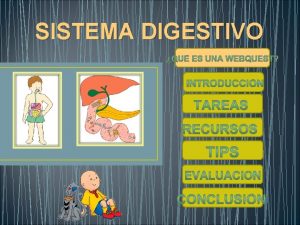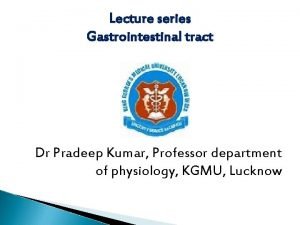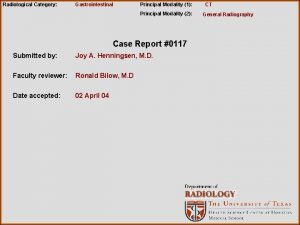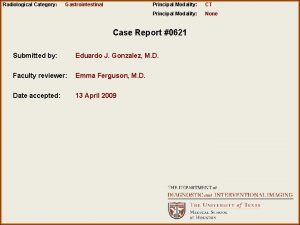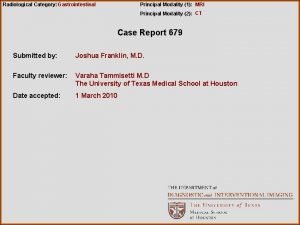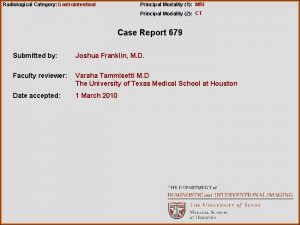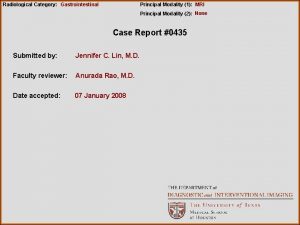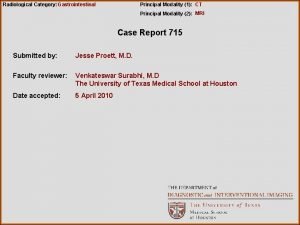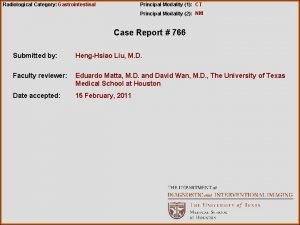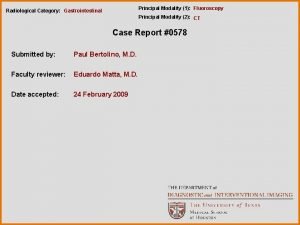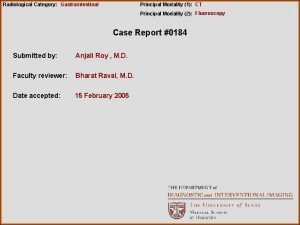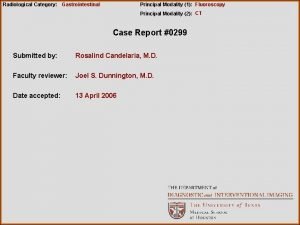Radiological Category Gastrointestinal Principal Modality 1 MRI Principal












- Slides: 12

Radiological Category: Gastrointestinal Principal Modality (1): MRI Principal Modality (2): None Case Report 0646 Submitted by: Vineet Seth, M. D. Faculty reviewer: Eduardo Matta, M. D. Date accepted: 15 January 2010

Case History Newborn male with acute liver failure. No abnormalities identified on prenatal ultrasound.

Radiological Presentations - Axial T 2 HI

Radiological Presentations – T 2

Radiological Presentations Axial T 2 (progressive increasing TE values) TR 2500 TE 6 TE 9 TE 15 TE 12 TE 18

Radiological Presentations Axial T 2 Gradient TR 2500 TE 6 TE 9 TE 15 TE 12 TE 18

Test Your Diagnosis Which one of the following is your choice for the appropriate diagnosis? After your selection, go to next page. • Glycogen Storage Disease • Amiodarone or gold therapy • Primary hemochromatosis • Secondary hemochromatosis • Neonatal hemochromatosis

Findings and Differentials Findings: T 2 weighted imaging demonstrates diffuse, homogenous decreased T 2 signal of the liver. The contours are smooth. No hepatomegaly or splenomegaly is identified. The T 2 signal of the spleen, adrenals and pancreas is normal. Increasing the TE on sequential T 2 weighted images (long TR), demonstrates progressive decrease in hepatic T 2 signal. Gradient imaging demonstrate hepatic intensity hypointense to adjacent skeletal musculature. Noncontrast CT (not shown) demonstrated normal hepatic density. Differentials: • Primary hemochromatosis • Secondary hemochromatosis • Neonatal hemochromatosis

Discussion Hemochromatosis is an iron overload disorder in which there are structural and functional impairment of involved organs. Primary (idiopathic, hereditary) hemochromatosis has been genetically linked to an HLA gene located on the short arm of chromosome 6. Metabolic abnormalities involves major iron deposition involving the liver, pancreas, heart, and skin (Bronze Diabetes). However an important differentiating factor is uninvolvement of the reticuloendothelial system including spleen. Abnormal metabolic uptake of iron-bound transferritin and abnormal increase in iron absorption by mucosa of the duodenum and jejunum are also noted. The overall prognosis is poor with cirrhosis and hepatocellular carcinoma frequent complications.

Discussion Secondary hemochromatosis, also know as hemosiderosis, is secondary accumulation of iron in patients with increased iron intake, patients who have received multiple blood transfusions, anemic patients with multiple blood transfusions (e. g. , thalassemia major, sideroblastic anemia), as well as multitransfused cirrhotic patients. After saturation of the RES, iron accumulates in parenchyma cells of liver, pancreas, and myocardium. This is an important distinguishing factor in this case as no signal abnormality is identified in the spleen. Neonatal hemochromatosis is fetal or perinatal fulminant liver failure with disrupted iron handling leading to abnormal iron deposition. There is no genetic inheritance. Proposed etiologies have included transplacental infection, potential toxins, autoimmune or antibody mediated, or possible mitochondrial inheritance. The disease affects the liver first then can effect the pancreas, cardiac or endocrine system. The spleen and reticuloendothelial system is usually spared. Liver failure can occur as early as the 2 nd trimester, with possible intrauterine death. Treatment includes iron chelation, deferoxamine, and eventual liver transplantation.

Discussion Differential consideration would included glycogen storage disease, which would show increase or decrease attenuation of liver on noncontrast CT. Glycogen storage diseases can also have a association with multiple hepatic adenomas, in up to 60%. Amiodarone or Gold therapy can also be included in the MRI findings differential, however diffuse homogeneous increased attenuation of liver on noncontrast CT would be identified. T 2 gradient imaging has been used to help quantify the abnormal findings. Particularly the signal intensity ratios of liver to muscle or liver to fat help establish direct correlation with liver iron content better than T 2 relaxation measurements and are more accurate in quantifying liver iron content. Brant WE, Helms CA; Fundamentals of Diagnostic Radiology; 2 nd Edition. Boyd, Roland; Neonatal Hemochromatosis; www. e-medicine. com. Coakley et al; Complex Fetal Disorders: Effect of MR Imaging on Management- Preliminary Clinical Experience; Radiology; 1999; 213; 691 -696. Webb WR, Brant WE, Major NM; Fundamentals of Body CT; 3 rd Edition.

Diagnosis Neonatal hemochromatosis
 Erate category 2 eligible equipment
Erate category 2 eligible equipment National radiological emergency preparedness conference
National radiological emergency preparedness conference Radiological dispersal device
Radiological dispersal device Tennessee division of radiological health
Tennessee division of radiological health Center for devices and radiological health
Center for devices and radiological health Mri principal
Mri principal Embryo folding
Embryo folding Diagram of alimentary canal
Diagram of alimentary canal Emt chapter 18 gastrointestinal and urologic emergencies
Emt chapter 18 gastrointestinal and urologic emergencies Funções do estômago
Funções do estômago Esganadura
Esganadura Embriologia del sistema gastrointestinal
Embriologia del sistema gastrointestinal Intestinal villus
Intestinal villus





